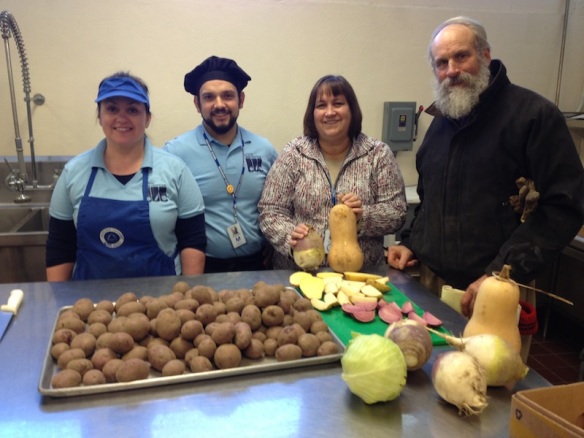To all my friends and colleagues in the school nutrition world: AASA, AFHK, AHG, AND, CSPI, CIA, SNA, USDA, agriculture, industry and food advocates of all flavors …
Those who know me professionally know that I have devoted my life to excellence in child nutrition programs. You know how strongly I believe that every child in American deserves to be well nourished and ready to succeed.
Those who know me personally will understand that my family situation (caring for my father in hospice at his home in California) prevents me from jumping into the current whirlwind of school lunch politics. I do not have the time or energy to sort through the conflicting claims and feeding frenzy of media messages to choose a particular side in this food fight. From what I have read, there are valid points on all sides. School meals are a complicated, nuanced issue, one that does not benefit from polarizing tweets and political rhetoric.
I am taking the “side” that I know best – one that often gets lost as the food fight heats up. I am supporting those who eat and cook school meals that rock. Millions of American children depend on school meals for the nourishment they need to succeed in academics, arts and athletics. Very often the quality of school breakfast, lunch, supper and snack far exceeds what they are fed at home or choose for themselves out in the world.
Thousands of dedicated, hardworking school nutrition professionals do their best every day to serve the healthiest meals possible –with reams of regulations, serious financial constraints, and complaints from every corner. I am not naïve; I know that nutrition nirvana in not found in every school. I also know that school nutrition programs do not serve “unlimited pizza and french fries every day,” kill kids with junk food, or want to roll back ten years of delicious improvements in school meals. Most are trying to develop farm to school contracts, plant school gardens and write grants for new kitchen equipment, while also helping kids to make healthier choices at school and home.
If I could wave a magic wand, I would ask everyone who cares about kids’ nutrition to take a deep breath, step back and think about how we can truly support school meals that rock. How can we find the middle ground without getting involved in a raucous election year debate that is more about being right than feeding hungry kids? How can we learn from districts that make smart nutrition work – recognizing vast differences among states and communities – to help those that are struggling? One nutrition solution does not fit all, but solutions in one district can help to inspire excellence in others.
We need many hands – from field to fork – to continue the positive changes in school nutrition programs. Legislators, farmers, ranchers, manufacturers, dietitians, chefs, superintendents, school nutrition professionals, parents and students need to talk with each other more –and yell about each other less. If everyone agrees that some flexibility in the meal standards probably makes sense, then let’s sit down and figure how to make that happen.
I doubt anyone inside the beltway is going to listen to my advice. Positions are now entrenched and politics are driving decisions more than science. For everyone else, if you want to get involved in school nutrition, here are my suggestions.
- Go eat a meal in your local school to experience the daily reality of feeding hundreds of hungry kids in minutes rather than hours.
- Spend some time in a school kitchen listening to what works under current guidelines and where flexibility would be helpful.
- Join your local school wellness committee, anti-hunger coalition or local food group to create strategies that work.
What am I going to do? Continue my virtual tour inviting Katie Couric – and anyone else who cares – to do school lunch in cafeterias around the country. Every day I discover a new school serving amazing choices, a new program planting actual seeds of healthy food or a new hero teaching children to cook delicious nutrition.



Thank you for much for your support Dayle! As a foodservice Director my hearts desire is to feed our student like I would feed my own Grandchildren, but it’s really hard with all the thing that are on our plates!! But I’m determined to do it in baby step’s so I can go forward with it. I would love to serve farm fresh clean food to every student!
Well said! We’re working hard here in Mendocino County, CA to do just this… focus on working together to create positive changes in our children’s health one step at a time.
Excellent post, Dale! I love your wide-angle and real-lens view of school food service challenges and successes! And I agree, it’s much easier to focus in on the negative than to celebrate the victories. As you always point out, there are plenty of victories to celebrate!
I also love the picture of the boy above with an amazing lunch in his hands! Hopefully, he enjoyed every bite. However, we often assume that that what is served is always consumed. A recent Harvard study suggests that Boston schools are seeing an encouraging, modest increase in fruit and vegetable consumption; however, a great amount of fruits and veggies served are still being thrown away. My hope is with the new relaxed nutrition standards, school lunch experts will have more leeway in creating meals that still include fruits and veggies but can now be offered in ways that all kids can really enjoy!
Dave
Thanks for your thoughtful comments. I agree completely about waste … my mantra: It’s only NUTRITION when they eat or drink it! Dayle
Pingback: Does the current school food fight benefit hungry kids and hard-working nutrition professionals? | Benefits of School Breakfast
Reblogged this on Benefits of School Breakfast.
Pingback: Don’t Put Your Eggs all in One Basket – There’s More than One Way to a Healthy Diet and Nutrition Counseling is Key | Chew The Facts
Dayle you hit the nail on the head. As you know I love this job and it’s probably been the most rewarding profession I’ve experienced . It troubles me by all this shenanigans . I hope all sides can sit down and come to a common sense of judgment on the rules and regulations.
I’m feeding kids for the summer primarily elementary k-4. As you know I normally deal with middle school and high school on a regular basis. There are big differences in the way the kids eat and except food buy age groups. I’ve learned in the past two weeks There is still a lot of work to be done at the early age groups . Getting kids to accept new foods Is a huge challenge . There are a lot of factors to get them to sit down and enjoy fresh new vegetables and fruits. Here are somethings to consider. When a child leaves school there is very slim chance of them experiencing that same food at home. Another high on my list is the amount time a child gets to actually consume their lunch. Unfortunately many kids receive good healthy lunches but really don’t have time to consume it . I realize there are many factors to this situation .
As the legislation meet with Sna Representatives I hope that all parties involve realize that too many irons stirring the fire at the same time eventually puts out the fire .
Thanks Dayle for taking the bull by the horn and leading it in the right direction.
Robert … thank you for taking the time to write such a heart-felt message. You do understand all the factors affecting school meals and so I appreciate your comments event more! Thanks for all you do to feed and educate children. Dayle
Keep working ,fantastic job! dbekeddffcdd